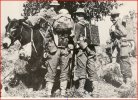who here uses the same technique for chopping with a kukri with other choppers and how much of a difference did you notice?
I found that using a kukri style wrist flick just before impact also works great with a 12" blade 1/8" thickness golok, the handle is shaped in such a way to really encourage this technique. It also seems to cut more efficiently with machetes. On the other hand, when using a hatchet it didn't seem to make much difference for me.
I found that using a kukri style wrist flick just before impact also works great with a 12" blade 1/8" thickness golok, the handle is shaped in such a way to really encourage this technique. It also seems to cut more efficiently with machetes. On the other hand, when using a hatchet it didn't seem to make much difference for me.









